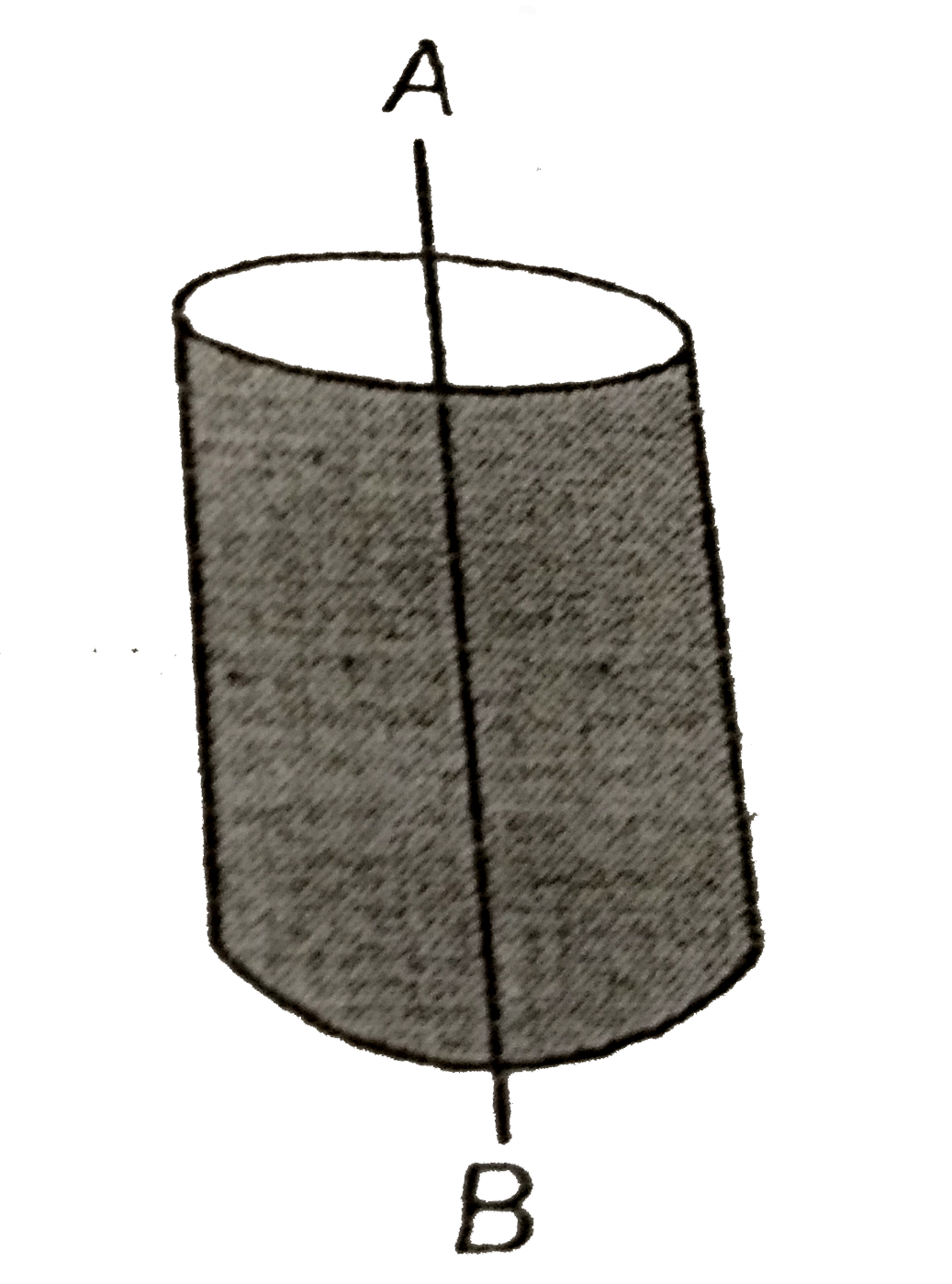Three particles of masses 1 g, 2g and 3 g are kept at points (2cm,0), (0.6 cm), (4cm, 3cm) find moment of inertia of all three particles (in gm−cm(2)) about (a) x-axis
(b). Y-axis
(c). Z-axis.
To find the moment of inertia of the three particles about the x-axis, y-axis, and z-axis, we will follow these steps:
Given Data:
- Masses:
- m1=1g at (2cm,0)
- m2=2g at (0,6cm)
- m3=3g at (4cm,3cm)
(a) Moment of Inertia about the x-axis:
The moment of inertia Ix about the x-axis is given by the formula:
Ix=∑mi⋅(yi)2
where yi is the perpendicular distance from the x-axis.
1. For m1:
- y1=0cm
- Contribution: I1=1⋅(0)2=0
2. For m2:
- y2=6cm
- Contribution: I2=2⋅(6)2=2⋅36=72
3. For m3:
- y3=3cm
- Contribution: I3=3⋅(3)2=3⋅9=27
4. Total Moment of Inertia about x-axis:
Ix=I1+I2+I3=0+72+27=99g-cm2
(b) Moment of Inertia about the y-axis:
The moment of inertia Iy about the y-axis is given by the formula:
Iy=∑mi⋅(xi)2
where xi is the perpendicular distance from the y-axis.
1. For m1:
- x1=2cm
- Contribution: I1=1⋅(2)2=1⋅4=4
2. For m2:
- x2=0cm
- Contribution: I2=2⋅(0)2=0
3. For m3:
- x3=4cm
- Contribution: I3=3⋅(4)2=3⋅16=48
4. Total Moment of Inertia about y-axis:
Iy=I1+I2+I3=4+0+48=52g-cm2
(c) Moment of Inertia about the z-axis:
The moment of inertia Iz about the z-axis is given by the formula:
Iz=∑mi⋅(ri)2
where ri is the distance from the origin, calculated using ri=√x2i+y2i.
1. For m1:
- r1=√(2)2+(0)2=√4=2cm
- Contribution: I1=1⋅(2)2=1⋅4=4
2. For m2:
- r2=√(0)2+(6)2=√36=6cm
- Contribution: I2=2⋅(6)2=2⋅36=72
3. For m3:
- r3=√(4)2+(3)2=√16+9=√25=5cm
- Contribution: I3=3⋅(5)2=3⋅25=75
4. Total Moment of Inertia about z-axis:
Iz=I1+I2+I3=4+72+75=151g-cm2
Summary of Results:
- Moment of Inertia about x-axis: Ix=99g-cm2
- Moment of Inertia about y-axis: Iy=52g-cm2
- Moment of Inertia about z-axis: Iz=151g-cm2
- Masses:
- m1=1g at (2cm,0)
- m2=2g at (0,6cm)
- m3=3g at (4cm,3cm)
The moment of inertia Ix about the x-axis is given by the formula:
Ix=∑mi⋅(yi)2
where yi is the perpendicular distance from the x-axis.
- y1=0cm
- Contribution: I1=1⋅(0)2=0
- y2=6cm
- Contribution: I2=2⋅(6)2=2⋅36=72
- y3=3cm
- Contribution: I3=3⋅(3)2=3⋅9=27
Ix=I1+I2+I3=0+72+27=99g-cm2
The moment of inertia Iy about the y-axis is given by the formula:
Iy=∑mi⋅(xi)2
where xi is the perpendicular distance from the y-axis.
- x1=2cm
- Contribution: I1=1⋅(2)2=1⋅4=4
- x2=0cm
- Contribution: I2=2⋅(0)2=0
- x3=4cm
- Contribution: I3=3⋅(4)2=3⋅16=48
Iy=I1+I2+I3=4+0+48=52g-cm2
The moment of inertia Iz about the z-axis is given by the formula:
Iz=∑mi⋅(ri)2
where ri is the distance from the origin, calculated using ri=√x2i+y2i.
- r1=√(2)2+(0)2=√4=2cm
- Contribution: I1=1⋅(2)2=1⋅4=4
- r2=√(0)2+(6)2=√36=6cm
- Contribution: I2=2⋅(6)2=2⋅36=72
- r3=√(4)2+(3)2=√16+9=√25=5cm
- Contribution: I3=3⋅(5)2=3⋅25=75
Iz=I1+I2+I3=4+72+75=151g-cm2
- Moment of Inertia about x-axis: Ix=99g-cm2
- Moment of Inertia about y-axis: Iy=52g-cm2
- Moment of Inertia about z-axis: Iz=151g-cm2
Topper's Solved these Questions
- ROTATIONAL MECHANICSBook:DC PANDEYChapter:ROTATIONAL MECHANICSExercise:Solved Examples
Explore 25 Videos
- ROTATIONAL MECHANICSBook:DC PANDEYChapter:ROTATIONAL MECHANICSExercise:Miscellaneous Examples
Explore 2 Videos
- ROTATIONBook:DC PANDEYChapter:ROTATIONExercise:(C) Chapter Exercises
Explore 39 Videos
- ROTATIONAL MOTIONBook:DC PANDEYChapter:ROTATIONAL MOTIONExercise:Integer Type Questions
Explore 17 Videos
Similar Questions
Particles of masses 1g, 2g, 3g ….100g are kept at the marks 1cm, 2cm, 3cm …., 100 cm respectively on a metre scale. Find the moment of inertia of the system of particles about a perpendicular besector of the metre scale.
View SolutionParticles of masses 1g, 2g, 3g, ……. 100g re kept at the marks 1 cm, 2cm, 3cm,………. 100 cm, respectively on a metre scale. Find the moment of inertia of the system of particle about a perpendicular bisector of the metre scale.
View Solution
Knowledge Check
In an arrangement four particles, each of mass 2 gram are situated at the coordinate points (3, 2, 0), (1, –1, 0), (0, 0, 0) and (–1, 1, 0). The moment of inertia of this arrangement about the Z-axis will be
A8 unitsB16 unitsC43 unitsD34 unitsA particle of mass 1 kg is kept at (1m,1m,1m). The moment of inertia of this particle about Z-axis would be
A1kg-m2B2kg-m2C3kg-m2DNone of theseThree particles of masses 1gm,2gm&3gm are at 1cm,2cm&3cm from the axis of rotation respectively then the moment of inertia of the system & radius of gyration of the system respectively are …. gmcm2 and ….. cm
A63,2.449B60,4.5C36,4.449D36,2.449
Point masses 1,2,3and4kg are lying at the point (0,0,0),(2,0,0),(0,3,0) and (–2,–2,0) respectively. The moment of inertia of this system about x-axis will be
View SolutionThree particles, each of mass 200 g are kept at the corners of an equilateral triangle of side 10 cm. Find the moment of inertia of the system about an axis
a. joining two of the particles and
passing through lone of the particle and perpendicular to the plane of the particles.
View SolutionThree particles each of mass 12 g are located at the vertices of an equilateral triangle of side 10 cm. Calculate the moment of inertia of the system about an axis passing through the centroid and perpendicular to the plane of the triangle?
View SolutionThe moment of inertia of a cylinder of mass 1000gm and radius 20cm about the axis AB shown in figure is

View SolutionTwo point charges 8 μC and −8μC are kept at points (-2cm, 0) and (2cm, 0), respectively. Calculate the electric potential at points (0, 7cm) and (4cm, 0).
View Solution
